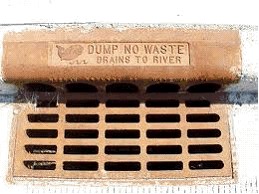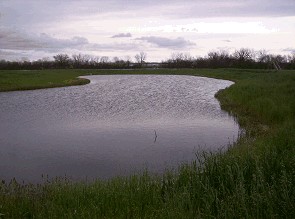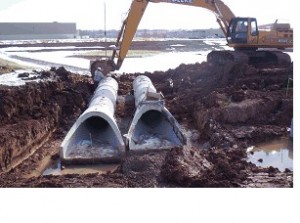Historically the storm sewer system’s primary function was to remove the rainwater from the streets. The water enters catchbasins, like the one shown below, which are connected to underground pipes. The pipes then transport the water to Lake Winnebago, the Fox River or the Neenah Slough (the water does not go to the treatment plant).
Today the storm sewer system is also used to protect the environment. The City and businesses have been installing structural devices such as detention ponds, bio-filters and cleaning manholes to remove sediment and nutrients from the runoff before it enters the lake. The City also sweeps streets, picks up leaves and cleans catch basins to keep the water entering our waterways clean.
2022 Stormwater Annual Report click here
The City of Neenah is
required to have a Municipal Separate Storm Sewer System (MS4) permit
along with other larger communities in the state as per Wisconsin Adm.
Code NR 216. As part of the permit the City must perform the activities
list below:
The City also has to comply with the standards set by the Lower Fox
TMDL (Total Maximum Daily Load) and the Upper Fox/Wolf TMDL. The TMDLs
establish the maximum amount of total suspended solids (TSS) and total
phosphorous (TP) that the City’s storm system may release to the
waterways. The City has a number of years to meet the TMDL requirements
which will require numerous ponds and other best management practices
BMPs. More information on these TMDLs can be found on the DNR website http://dnr.wi.gov/topic/tmdls/.
A stormwater utility
was created to fund the structural and operational best management
practices (BMPs) required to comply with the City’s MS4 permit and TMDL
limits.
The utility charge is based on an equivalent runoff unit (ERU). An
average single family home is equivalent to 3,138 square feet of
impervious area or one ERU. More information on the stormwater utility
and charges may be found in the Neenah Code of Ordinances Sec. 17-101 to
140 (click here).
 Construction
Construction
sites with 20,000 square feet or more of impervious surface disturbance
and sites with one acre or more land disturbance shall reduce the total
suspended solids (TSS) and shall reduce the peak discharge prior to the
runoff leaving the site.
All requirements for Post-Construction Stormwater Management can be
found in Sec. 22-322 to 350 of the Neenah Code of Ordinances (click here).
Learn how you can make a difference at RENEW OUR WATERS.
Become involved with stormwater projects that improve our community at Sustainable Neenah.
 Erosion
Erosion
control during construction is perhaps the single most important
element in protecting our waterways from sediment no matter how small
the project. Whenever the ground is disturbed there is a potential for
soil to be washed away and carried into our lakes and streams.
All land disturbing construction activity within the City of Neenah
shall obtain a permit prior to commencing. Permit requirements can be
found in Sec. 22-290 of the Neenah Code of Ordinances (click here).
SITE MAP | DISCLAIMER | ACCESSIBILITY & COMPLIANCE | © City of Neenah. All Rights Reserved. Web Design & Development by Stellar Blue Technologies.
SITE MAP | DISCLAIMER
ACCESSIBILITY & COMPLIANCE | © City of Neenah. All Rights Reserved. Web Design & Development by Stellar Blue Technologies.